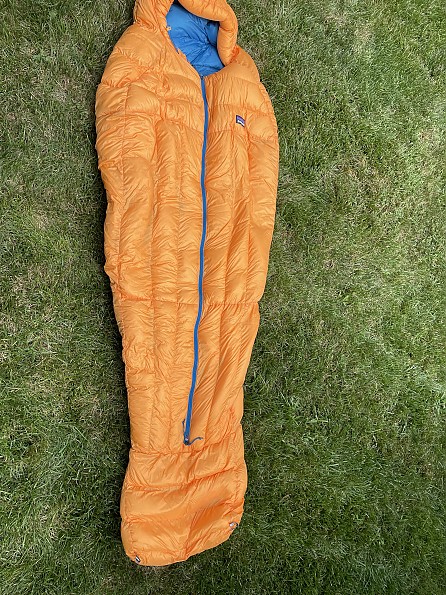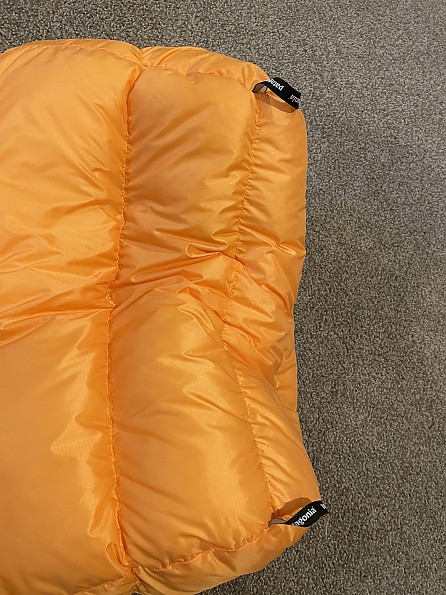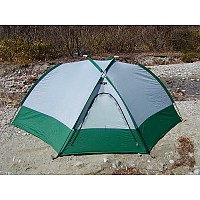Patagonia Fitz Roy 30°

The Fitz Roy is a well-made, roomy, three-season down sleeping bag. Vertical baffles and a center zipper set this apart from many comparable bags. I particularly appreciated the quiet fabric, well-shaped hood and foot box, and dual baffles flanking that center zipper. True ultralighters may find this too bulky and heavy (short weighs 28 oz., regular 29 oz., long 30 oz.), but this is three-season bag should serve backpackers and car campers well.
Pros
- good quality down
- reasonably lightweight
- solid features
- roomy, if that’s appealing
Cons
- there are options that stuff smaller and weigh less
- cost
INTRODUCTION
Patagonia is a relatively new participant in the sleeping bag market but seems to have come up with a strong option. The Fitz Roy 30-degree sleeping bag I tested is a size long (up to a six-foot, six-inch person), is filled with 800 fill power down, and weighs 30 ounces/1.875 pounds. It also comes in short for people up to five foot, six inches (weighs 28 oz.) and regular for people up to six feet (weighs 29 oz.). Additionally, there is a 20-degree Fitz Roy.
Putting this in perspective, sleeping bags that use the highest quality down, 850-900+ fill power, supply the same or better warmth in a bag that weighs 3-5 ounces less than the Fitz Roy 30. Consequently, this sleeping bag is better than average in terms of warmth-to-weight ratio, but it's not the lightest or most compact bag available.
Note that I'm five feet, nine inches. I always get sleeping bags in size long because I stow boot liners and damp layers around the toe box when I sleep. Sleeping with these things in the foot of the sleeping bag keeps them warm and helps them dry out overnight.
The Fitz Roy 30 uses 800 fill power down, which is a very lofty, lightweight insulator. The higher-end, lighter-weight bags use down that’s in the 850-900+ fill power range, which is one reason those bags weigh a little less. Patagonia does not publish how many ounces of down it puts inside its sleeping bags.

Patagonia injects some socially-conscious effort into its products. This sleeping bag is Fair Trade Certified sewn, which means Patagonia pays a premium for the manufacturing that goes directly to workers at the factory. Patagonia also claims that "87% of our line uses recycled materials," and the label on the bag states that the nylon shell is recycled. Also, Patagonia uses down that can be traced from parent farm through processing in an effort to help protect against force-feeding and live-plucking of the birds that supply the goose or duck down. Finally, Patagonia uses a dyeing process that it claims reduces water usage by 90% and carbon emissions by over 95%.
Patagonia also guarantees its products for life, subject to wear and tear damage, and offers mail-in repair service. I can't speak to their sleeping bags, but Patagonia replaced a hard shell of mine after several years of use when the waterproof/breathable membrane delaminated.



Patagonia also makes a Fitz Roy bag rated to 20 degrees Fahrenheit, also in short, regular, and long. The bags are gender neutral, no men's or women's variations.
SLEEPING COMFORT
My most important category: how does it feel to actually sleep in the bag?
First, I really like the fabric Patagonia used with this bag. It’s 20 denier nylon, so it is lightweight. However, it is also very soft to the touch and "quiet" in the sense it doesn’t make crinkly noises when I move around. Some of the lightest and toughest modern fabrics have a bad habit of being noisy, which can be annoying in a small tent.
Second, the warmth rating appears to be accurate. It has been a little tough to test the limits of this bag’s warmth this summer; overnights in our local mid-Atlantic area have been steamy, and evenings were on the warm side on a hike in New Hampshire. The coolest night I experienced was in the mid-high 40s, and I slept with the bag mostly unzipped. Read on re: the multiple zipper pulls, which enable some flexibility for ventilation purposes. I will update this review after I have used the bag in colder weather.


Third, this bag is fairly roomy inside. Patagonia doesn’t publish circumference measurements for the foot box, hip, or shoulder. From experience, it’s apparent this bag is on the wider side of the spectrum. Some companies make their bags lighter by using a narrow cut; it’s pretty hard to sleep comfortably if a bag is too narrow, though. I tend to move around from back to side and appreciated this relatively spacious bag.
Finally, the foot box and hood struck a nice balance between providing enough space yet also feeling like they’re enveloping your feet and head in warmth. This can be particularly important as temperatures fall; it’s harder to sleep well with a hood that isn’t well-shaped or easy to adjust.


FEATURES
The center zipper distinguishes this bag from many competitors. Most sleeping bags zip along the size. The center zipper probably influenced the decision to use vertical vs. horizontal baffles. I liked being able to mostly unzip the bag for warmer weather and have heat vent out the top.
I was initially concerned the center zip would bleed heat in colder weather. Patagonia thoughtfully placed dual baffles beneath the zipper, which should deal with that issue effectively. The bag also has thicker nylon fabric on each baffle, immediately next to the zipper, to discourage snags.
Other features to note:
- a small, zippered pocket on the left side of the zipper in the chest area for stowing a headlamp and smaller phone,
- two hang loops on the foot box for airing the bag out; and
- a trio of zipper pulls that provide more sleeping options.





HOW I USED AND TESTED THIS SLEEPING BAG
The Fitz Roy arrived after weather had warmed up quite a bit in Maryland. I had a few short overnights locally where I slept out in warm weather—60s and low 70s in a tent. I also took the bag on a hike in New Hampshire’s White Mountains, where I expected cooler temperatures but ended up with high 40s/low 50s for the overnights.
I slept on a Therm-a-Rest NeoAir Xtherm pad that claims an R value of 6.9, a four-season pad, and an Alps Mountaineering inflatable pillow on each outing. (Sleeping out is definitely a package deal. A good pad and pillow make a huge difference!) On the warmest nights, I fully unzipped the bag and flipped it to use it more like a quilt, with my feet in the foot box. That worked better for me for the warmest weather because, even with warm weather, having the bag fully open left me a little chilly.
As noted, I will update this review after some cooler-weather outings, hopefully in a hammock as well as a tent.
TAKEAWAYS
The Fitz Roy 30 is a three-season bag that should take hikers and campers well into the shoulder season. The bag has a lot going for it. High quality materials, smart design, interesting features, a center zip that I think gives the bag more flexibility for ventilation, and a company that has a really good guarantee and repair policy.
It is on the higher end of the spectrum in terms of price and warmth-to-weight ratio—better than most, and a tad heavier and bulkier than the highest-end brands. The Fitz Roy 30 is priced accordingly, about 20% less than the most expensive comparable sleeping bags. Hikers intent on saving as much space and weight as possible might prefer sleeping bags from higher-end specialty companies that use 850 or 900+ fill power down but should expect to pay a premium for that.
Background
A number of overnights and a longer multi-night hike.
Source: received for testing via the Trailspace Review Corps
(Sample for testing and review provided by Patagonia)
Your Review
Where to Buy
You May Like
Specs
| short | regular | long | ||
|---|---|---|---|---|
| Price |
MSRP: $429.00 Historic Range: $399.00-$459.00 |
|||
| Weight | 794 g / 28 oz | 822 g / 29 oz | 850 g / 30 oz | |
| Fits | 5'6" | 6'0" | 6'6" | |
| Shell and liner |
1.1-oz 20-denier 100% recycled nylon ripstop (solution-dyed) with a PFC-free DWR finish (durable water repellent coating that does not contain perfluorinated chemicals) / Fair Trade Certified sewn |
|||
| Insulation |
800-fill-power Advanced Global Traceable Down (goose down certified by NSF International to help ensure the birds that supply it are not force-fed or live-plucked) |
|||















 Reviewed by
Reviewed by



